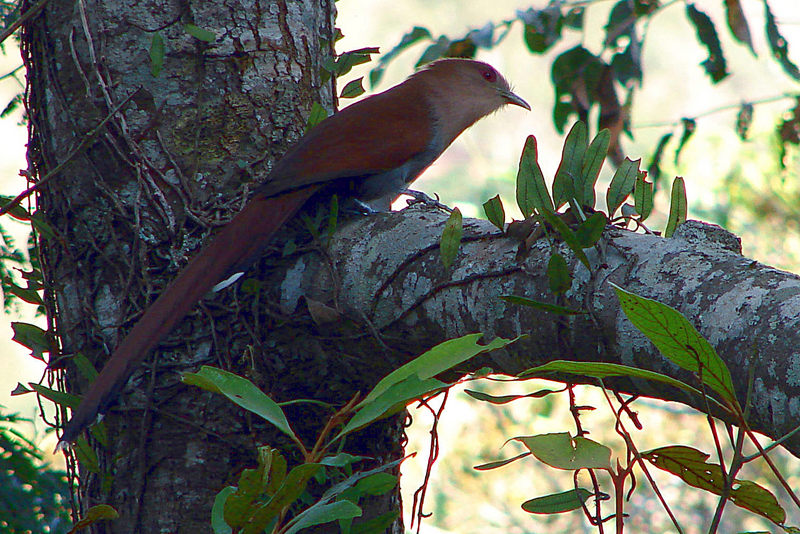Squirrel Cuckoo
From Wikipedia, the free encyclopedia
Order: Cuculiformes
Family: Cuculidae
[Photo] Squirrel cuckoo (Piaya cayana). (Pt-br="alma de gato"; "Alma de caboclo"). Location: Petropolis city, Rio de Janeiro. Date September 2007. Author: Eurico Zimbres (http://commons.wikimedia.org/wiki/User:Zimbres).
The Squirrel Cuckoo, Piaya cayana, is a near-passerine bird. This cuckoo is a resident breeding bird from northwestern Mexico to northern Argentina and Uruguay, and on Trinidad.
This large species is 43-46 cm long and weighs 95-105 g. The adult has mainly chestnut upperparts and head, becoming paler on the throat. The lower breast is grey and the belly is blackish. The tail is boldly banded in black and white. The bill and bare eyering are yellow and the iris is red. Immature birds have a grey bill and eyering, brown iris, and less white in the tail.
There are a number of subspecies with minor plumage variations. For example, P. c. mehleri, a South American form, has a brown-and-white banded tail.
It makes explosive kip! and kip! weeuu calls, and the song is a whistled wheep wheep wheep wheep.
The Squirrel Cuckoo is found in woodland canopy and edges, second growth, hedges and semi-open habitats from sea level to as high as 2500 m altitude, although it is uncommon above 1200 m. This species’ English name derives from its habit of running along branches and leaping from branch to branch like a squirrel. It normally flies only short distances, mainly gliding with an occasional flap.
It feeds on large insects such as cicadas, wasps and caterpillars (including those with stinging hairs or spines), and occasionally spiders and small lizards, rarely taking fruit. Its static prey is typically taken off the foliage with a quick lunge, but wasps may be picked out of the air.
The nest is a cup of leaves on a twig foundation, hidden in dense vegetation 1-12 m high in a tree. The female lays two white eggs.
The Squirrel Cuckoo is plentiful in most of its range and appears to be quite tolerant of human disturbance, as long as wooded land remains. It is considered a species of Least Concern by the IUCN.
http://en.wikipedia.org/wiki/Squirrel_Cuckoo
| The text in this page is based on the copyrighted Wikipedia article shown in above URL. It is used under the GNU Free Documentation License. You may redistribute it, verbatim or modified, providing that you comply with the terms of the GFDL. |
|

